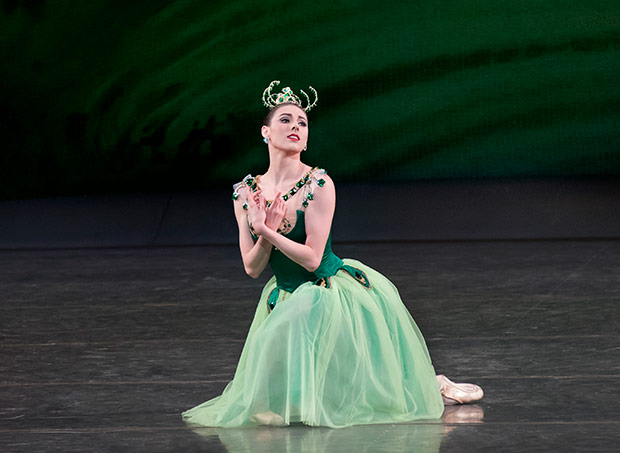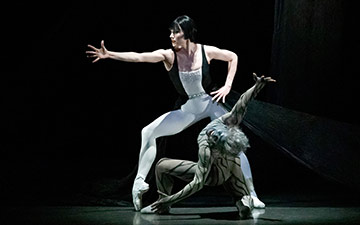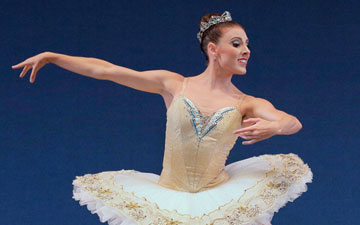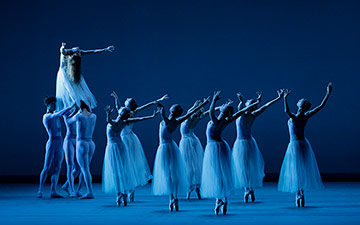
© Paul Kolnik. (Click image for larger version)
New York City Ballet
19 Sept – Jewels: Emeralds, Rubies, Diamonds
21 Sept – All Balanchine: Concerto Barocco, Tchaikovsky Pas de Deux, Stravinsky Violin Concerto, Symphony in C
★★★★✰
New York, David H. Koch Theater
19, 21 May 2018
www.nycballet.com
davidhkochtheater.com
Getting it Right
The New York City Ballet has often been in the news of late, for all the wrong reasons. First, back in January, its longtime director Peter Martins resigned under a cloud of allegations, sexual and otherwise. Then, a few weeks ago, two of its principal male dancers were suspended, and then fired, when accusations that they and others had exchanged sexually-explicit images of women (including women in the company) came to light. A third resigned before he could be fired. The dancers and the company are being sued by one of the women, whose photograph, unbeknownst to her, was included in these exchanges. She blames not only the dancers but the company itself for creating what, in her suit, she refers to as a “fraternity-like atmosphere.” These are allegations, of course, and in the ensuing weeks and months it may be clear who said and did what and when. But the litany of tasteless remarks included in the suit is dismaying in and of itself.
All of this is taking place as the company is still in the process of identifying a replacement for Martins; since January, artistic and staffing decisions have been made by a quartet composed of three young ballet-masters and Justin Peck, choreographer-in-residence. Jonathan Stafford is the first among equals – he was the person who was given the job of explaining the company’s reasons for firing the men in the sexting scandal. The four seem to be doing as good a job as one could hope under the circumstances. But the company needs a new leader, someone who can set things right, investigate the roots of the company’s current problems, and clear a path toward a new, more open, less rumor-filled chapter in its history. The sooner the better. Hopefully it will be someone with vision and strong character, good taste, a sense of purpose, and, especially important under the circumstances, an unwavering ethical core.

© Paul Kolnik. (Click image for larger version)
The impulse in some quarters has been to kick the company while it’s down. The former NYCB dancer Toni Bentley penned an op-ed for the New York Times, in which she accused the company of reaching its “nadir” and of filling Balanchine’s stage with “rot.” “The cathedral has crumbled,” she writes, dramatically. Others, like the musicologist Jim Steichen (whose book Balanchine and Kirstein’s American Enterprise will come out in November), have more reasonably called for a reckoning with Balanchine’s own “sexual and psychological exploitation” of women in the company over the decades he led it. Balanchine had relationships with a series of dancers, some of whom he married. At times, as when he drove Suzanne Farrell to leave the company after she became engaged to another man, he behaved spitefully toward them. All this is part of the historical record, though there has been a tendency to treat his behavior as part of his mystique. The women were his muses, goes the argument; no-one’s feelings were ever hurt; it was all perfectly marvelous and inevitable and charming.
Of course, those were different times; male-female behaviors that today seem abhorrent were considered acceptable, even admirable. It would be useful to stop treating these transgressions as a romanticized facet of the artistic personality and see them for what they are. And this is increasingly the case, with the exception of a generation of dancers who knew and loved him, and critics who came of age professionally watching him work. (And that, too, is understandable.)
I’m more interested in what is happening now and will happen in the future. As I’ve written before, one thing that worries me about City Ballet – repository of one of the great repertories of dance, and home to a remarkable group of dancers – is its lack of transparency. There seems to be no sense of urgency, at least in its public stance, to assure the world that steps are being taken and that the dignity and hard labor of the dancers is being evaluated seriously. A new administration would not only set a new path, but also create a dialog around what is and is not acceptable among dancers and between dancers and management. It’s not a question of prurient curiosity. It’s about the City Ballet reaffirming its civic and esthetic mission, so clearly exemplified by the ballets it performs on its stage: civility, courtesy, mutual respect and autonomy. Those concepts change and develop over time, and so should a company’s ethos.

© Paul Kolnik. (Click image for larger version)
And now I’ll get off my high horse and talk a about the dancing. There is a lot to say. This was the first week of the company’s fall season. On display were two all-Balanchine programs, one devoted to the full-evening Jewels, the other to a mixed bill. The company seemed to be dancing with a special ferocity, as if to prove its worth and convince the world that this enterprise is, indeed, worth preserving and saving.
Because of the departure of the three principals (Chase Finlay, Amar Ramasar, and Zachary Catazaro), and the quite recent retirement of Robert Fairchild, the company is rather low on upper-level men. (Joaquin De Luz will soon depart as well; Oct. 14 is his farewell.) This has created a space for various male débuts, most notably Joseph Gordon in Diamonds and the first movement of Symphony in C. In both, Gordon showed himself to be more than deserving. He is an attuned and un-flustered partner, though not yet a completely effortless one. In Diamonds, he gave great attention to matching his partner (the mercurial Sara Mearns) in her port de bras and the shapes she created with her upper body. Every move he made complemented her line. He also has the thoughtful expression of a real person onstage; you want to know his thoughts. He didn’t just dance; he added small details to his characterization, a look, a nod of the head, a pause to acknowledge the dramatic situation. Technically, he acquitted himself well; clean fifth, nice plush plié, long lines, good turns. (He seemed to have no trouble with the quick, filigree footwork in the first movement of Symphony In C, either.) Mearns gave her usual blazing performance, but Gordon did not disappear. He commands the stage, quietly.

© Paul Kolnik. (Click image for larger version)
Taylor Stanley was electric in Stravinsky Violin Concerto, set to a prickly, dissonant score full of ironic and stylistic jokes and harmonic tight corners. The exotic, angular shapes created by Balanchine to this score are a playground for Stanley: he juts his hips, twists his wrists, crouches, contracts and expands. The highly rhythmic music excites his imagination and muscles. He danced the first, more aggressive of the two pas de deux, with Sara Mearns, and gave a good fight, even though, per the choreography, he ended up on his back. He seemed less at ease in the first section of Emeralds, where he was paired with a sumptuously musical Tiler Peck. There was nothing precisely wrong with his dancing here, but it lacked conviction; he was clearly finding his way. Also worthy of mention, Sebastian Villarini-Velez’s début in the third movement of Symphony in C, alongside Indiana Woodward (another début): playful, breezy, buoyant.

© Paul Kolnik. (Click image for larger version)
The need for new men to step into bravura male roles was made clear by some of the performances by veterans who made it through the steps only by taking shortcuts and fudging the details. I won’t name names, but you know who you are! This was not, however, true of Joaquin De Luz who, at 42, is dancing with the cleanness and energy of a much younger man. The young dancers in the company should watch him. He and Peck gave an explosive performance in Tchaikovsky Pas de Deux, egging each other to ever greater speed, attack, flourish. He’s a showman, and so is she, when called to be. The audience gave them several curtain calls.

© Paul Kolnik. (Click image for larger version)
Of course, it’s not only about the men. There were important débuts for women in the company this week: Claire Kretzschmar as the leggy amazon in Rubies, and Unity Phelan in Mimi Paul’s role in Emeralds. That’s the second female soloist; who walks and walks and walks on pointe, as if stepping on rocks in a lake. Kretzschmar was fierce, slashing at the air with her long legs as if wielding a whip. She could use a bit more grandeur; the amazon is a cool dominatrix, who plays with men for sport. Phelan, endowed with a gymnast’s flexibility, looked somewhat cowed by her role in Emeralds, which requires a more weighted, almost disembodied approach to the steps. Her character exists almost outside of time; she’s half woman, half memory. Phelan has yet to find this quality, or another, more interesting one.
The conductor for Emeralds was Andrew Litton, who drew a bold, defined sound from the orchestra in each of the three sections. One could hear every shift in orchestral color; the rhythms were sharp and incisive. The sound had contour. In the mixed bill, maestro Clotilde Otranto got off to a wobbly, un-focused start with Concerto Barocco. The dancing, too, was a bit unfocused.
So, this is why it all matters. It’s about the ballets, and about the people. Their hard work matters. The rigor and excellence of the repertory matters. Labor and ideals – that’s what ballet is all about (or should be). Most of all, the dancers of New York City Ballet deserve the respect of their peers, their employers, the donors, and the audience. The women, and also the men. This is 2018; we should be putting the age of abusive donors, bosses, and colleagues behind us. And if it doesn’t happen, the dancers will begin to leave, and the “cathedral” will truly collapse. Let’s hope the board, the money people, those who run the show, realize this and do the right thing.

















Ms. Harss,
Your insightful article was a pleasure to read. I concur wholeheartedly. One tiny mistake: (I am a bit of a Miss Thistlebottom…lol) “….the two seem to be doing as WELL a job…”. It is as “GOOD” a job…..
Undoubtedly, you started to write, “…as well as can be expected….” but then, changed to, “as …..[ ] a job…”. A super-attentive editor might have caught it.
I do enjoy your writing and agree with your analysis.
Cheers!
Donna Ross
(former dancer, Joffrey Ballet, NYC, 1976-1978
Dear Donna, oh my god, you understood EXACTLY what happened. Thank you for being so understanding, and for your eagle eye.
Duh – all fixed. Ed